About John P.
One Man's Blog
Specialization is for Insects.

CatamaYak: How to Build a Kayak Catamaran

August 14, 2013 By John P.
We happen to own four identical kayaks, we bought the Equinox 10.4 kayaks at Costco, and we started working on ways to hack them to make them even better! First, I hacked a motor onto my kayak , and then I thought I’d give it a shot and see if we could build a catamaran out of a couple of em.
The CatamaYak Concept
When we go out on the water there is usually a group of us. Some are faster than others, and some just enjoy a leisurely time on the lake. We wanted to be able to turn a couple of kayaks into a floating relaxation station and give it a motor so that a couple of people could simply sit back and relax while still being able to tag along.
The CatamaYak needed to have a few important characteristics:
- be light and easy to assemble at the lake
- be extremely waterproof and not get slippery
- be durable enough to take a pounding from the waves
- be rigid enough to deal with the forces encountered
Given the design considerations I took a few measurements and drew up a quick sketch of the components and how I imagined they would fit together.

If you are going to design your own there are a few important things to keep in mind.
- The bow (nose) of the kayak is generally narrower than the stern (rear). So don’t just make the front and rear crossbeams the same length or it will look funny and not perform as well.
- You could substitute wood 2x4s for PVC in my design, but its not going to last as long and its going to flex and expand as it takes on water. Its also going to be a LOT heavier.
- If you intend to add a motor like I did you must make sure that the distance between the two kayaks in the center is sufficient for the motor to turn 360 degrees without the blades hitting the side of the watercraft.
The Kayak Catamaran Parts List
Everything I used for this experiment came from Lowe’s. I’m sure you could also find it at Home Depot or other home improvement stores.
- 3 – 10′ sections of 2″ PVC pipe
- 4 – 2″ PVC T sections
- 4 – 2″ PVC end caps
- PVC cleaner and cement
- 1 – 18″ x 72″ wood board
- 4 – 2″ stainless steel U bolts with lock nuts and washers
- 4 – 5″ stainless steel eye bolts with lock nuts and washers
- 1 – 8′ 2×4 (or a couple of 8″ scraps)
- 2 – 8″ 5/8×16 bolts with lock nuts and washers
- 4 – Ratcheting straps
I also needed a rubber mallet, wrenches, a drill, a set of drill bits, and a table saw. You could do without the table saw by having the store cut the wood for you.
Building the Kayak Catamaran
The first thing I did was set the two kayaks beside one another and lay the crossbeam PVC pipes on top of it. This allowed me to take measurements and make sure my design was roughly accurate.

It turns out that the exact finished dimensions worked perfectly for my kayaks and particular brand of trolling motor (Minn Kota 30 pound unit). See the design sketch above if you have Equinox 10.4 kayaks and want to exactly duplicate this build.
I then cut all the PVC pipes and dry fit the pieces. I used my table saw to cut the PVC, but you could use a hacksaw and do it by hand, or you could use a reciprocating saw or basically anthing with a blade long enough to go through 2″ of PVC. Its a very soft material so its easy to cut – but keep your cut very straight as you go. The pieces won’t fit properly if the cuts are all crooked.

Then it was time to attach the pieces. First, you must start with the rectangular center frame, and you have to be VERY careful when assembling this piece to make sure you get it extremely straight!
I carefully cleaned and cemented each fitting and lightly attached a T union to one end of the support frame. I then VERY QUICKLY laid it on the flat piece of wood to make sure the T’s were pointing straight. After a little adjusting I took a rubber mallet and pounded the T’s on as far as they would go.

You’ll know when the pieces are fully inserted because there is a little ridge in each connector or end cap that won’t let the pipe go any farther. So you don’t need to worry that you put it in too far. In fact, if you follow my design its extremely important that all PVC is assembled as tightly as possible for proper fit and structural integrity.
If done right you can look inside the T fitting and see there are no gaps and some of the cement is pretty much sealing all the way around the tube where they meet.

First glue up both end pieces, then attach the two long PVC supports to one end, and follow up by attaching the other end piece – which will require you to glue up two pipes at the same time. Work quickly as the PVC cement drys fast! And remember – HAMMER EVERYTHING TOGETHER WITH A RUBBER MALLET!
After that you’re in the home stretch. Time to glue on the cross beam pieces. These are the most critical joints so make sure they are very clean and you have plenty of cement. You don’t want these to break on the water! Also, notice again that in my design the front and rear are different lengths. Here is a photo showing just one side glued up.

Once you’ve finished connecting all the PVC joints and adding end caps, you can lay the frame back down on your kayaks and begin attaching the connecting hardware. First up, the wooden platform needs to be connected on top. This serves two purposes. First, it provides a lot of torsional rigidity. And secondly, it gives you a spot where you can put stuff!
I used 4 long eye bolts pointing upwards to connect the wood to my PVC frame by drilling down through the wood and directly through the center of each of the 4 T-connectors in the corners. By using the eye bolts it gives connection points in each of the 4 corners that can be used for lashing things to the top, or could even be used for lifting / hanging the platform.

You’re going to attach 4 eye bolts pointing downward from the end of each crossbeam. These are going to be used for connecting the ratcheting strap to hold the kayaks in place.

The other end of the strap mounting is a U bolt mounted directly on the platform. Make sure and leave enough room that the ratchet can be entirely on top when its mounted securely. This does a couple of things, but most importantly it allows you to ratchet it up a little while on the water if it loosens up, which it will do a bit when it gets wet. I’ve already proven out this point on the Lake, so don’t skip it.

You’re about done at this point! Now if you intend to mount a motor on it you need to add a wood block that will fit it. I accomplished this by cutting two 2×4″s down to 8″ wide. These were attached with several stainless steel screws and an L bracket (found near the fencing stuff in the lumber department) for some added rigidity. I wanted to make sure there was NO flex with the motor so all of the power translated to forward momentum instead of any wiggle in the mount.

At this point you should be done and ready to simply slip a ratcheting strap under each mounting point, front and rear, on both Kayaks and secure them tightly.
We took the double Kayak Catamaran out on the lake for the day and it performed FAR better than I ever expected! The little 30 pound Minn Kota trolling motor was able to EASILY push the watercraft! By the way, you need to really watch the video I did about the single Kayak motor mount in order to see how to wire it up and which battery to use, etc. But even with the little trolling motor battery I used we were out on the lake messing around with the motor in use for over an hour and only used 20% of the battery life.

Not only was this rig able to easily push and steer the CatamaYak, but we were able to even TOW both of the other Kayaks without any issue! Amazing.

A couple of last little things. You’ll see in all of the photos that the wood panel in the middle is exposed untreated wood. That’s because we bought some special textured extremely waterproof paint to cover it with, but I didn’t do it before the first trip out to the lake. We’ll be painting it for long term durability soon.

Finally, if you do this, you’re technically changing your kayak into a home built motor boat. And in Texas, and probably most states, you’re going to have to register it as a watercraft. It costs like $30 in Texas to do it, but be warned that if the lake police come by you could be ticketed for taking this on the water without registration. So make sure you’re covered so you don’t worry about it.
Oh, and be prepared for a LOT of attention on the water! Because no one has ever seen anything like this before so they’ll all want to be checking it out!
So, that’s it! I hope you guys enjoy the hack / build. Let me know if you have any questions in the comments below and I’ll help as best I can. This is a project that you can build in just a couple of hours if you have the right tools, and the entire cost was around $100 including PVC, wood, bolts, paint, etc. So that’s a pretty good value!
John P. is a former CEO, former TV Show Host, and the Founder and Wizard behind Texas Metal Works . You can find him on Twitter , Facebook and LinkedIn . Feel free to send shoutouts, insults, and praise. Or Money. Money is good.
May 11, 2016 at 9:30 pm
This is awesome! I am with Robert on the straps..confused about the role of the U bolts. I thought the ratchet strap hooked back to the platform eye bolt. Please clarify. By the way John, why did you take yours apart?
May 12, 2016 at 10:32 am
I used the u-bolts on the platform so that the base of the ratchets could lay flat against the wood once everything was tightened up. This way when you’re on the water you can use one hand to ratchet it tighter if need be.
You may be able to use the same I look somewhere and put both ends of the ratchet on it. You just want to make sure that you have enough room for the straps to Route Around everything and still be accessible when you’re on the water. It could be fairly disastrous to have anything separate with your stuff on that Central platform. It would pretty much just think…
I disassembled mine because I wasn’t going to register it as a watercraft, and it takes up too much room in the garage for something I’m not using constantly. If we had a lake house I would have definitely left it hooked up. It was great! :-)
December 14, 2015 at 5:37 pm
This is something I have been wanting to do for a long time. Great instructions. One thing that isn’t clear to me is how the ratchet straps attach to the u-bolts. Could yo show a top view picture to make it easy to see? Thanks.
January 5, 2016 at 10:59 pm
Sorry Robert, I took it apart a while back so I can’t take a photo any more. But since the ratcheting straps have hooks on them, as long as you get them hooked into the eye bolt and just tighten them up, they’ll stay! :-)
April 10, 2015 at 10:53 am
Great modification! I have 2 identical Perception Sport Pescador 120 kayaks and this has definitely inspired me to build a similar setup. I also own a Hobie Adventure island and love the extra space gained from the trapoline sides between the kayak and the amas (just like your wooden platform has done). You could also add additional cargo space to the void formed between the wooden platform and the front of the two kayaks from a lightweight water repellent material. Great work, thanks for sharing!
July 14, 2014 at 9:27 am
I wanted to say thank you for posting this project. My son is handicapped and i had wanted to take him our on my kayaks and could not imagine how to make it safe for him to enjoy. This is perfect. We even got a thumbs up from the Vessel Assist Boat Crew on our Maiden Voyage. The stability is amazing even in Lake Washington with the chop and larger motorized vessels. Your measurements were spot on for our boats. High Five! Would love to share a pic. This has opened up a whole new world to a boy and his dog. Thank you!
July 23, 2014 at 11:30 pm
Yeah! I’m so happy to hear that this was helpful! :-)
August 15, 2013 at 8:33 am
That definitely seems easier than I thought.
August 14, 2013 at 2:40 pm
I was going to say if John built it a Catastrophe but it looks pretty good. Cali has large feet or John has small ones. :)
August 14, 2013 at 1:10 pm

How to Make a Catamaran Out of Two Kayaks? Here’s What You Need to Know
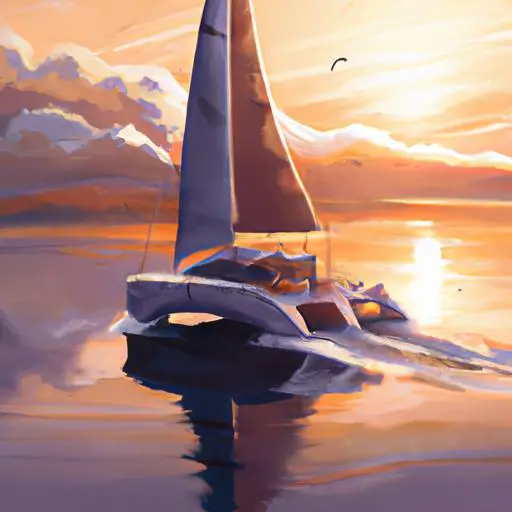
If you’re looking for an inexpensive and simple way to make your own catamaran out of two kayaks, then you’ve come to the right place.
In this guide, we’ll provide the necessary steps to create a stable and secure catamaran from two kayaks.
You’ll learn the benefits of making a catamaran out of two kayaks, the supplies you’ll need, a step-by-step guide to tying the kayaks together, constructing the platform, and more.
Plus, we’ll provide tips for ensuring a safe and fun day on the water.
So, let’s get started!
Table of Contents
Short Answer
Making a catamaran out of two kayaks is actually relatively simple and can be done in a few steps.
First, you’ll need to attach the two kayaks together using either rope or straps.
Make sure the kayaks are well secured together and evenly balanced.
Then, tie a cross beam between the two kayaks to make a platform for seating and storage.
Finally, add any additional gear, such as paddles and life jackets, that you may need for your journey.
With these steps, you’ll have your own DIY catamaran made out of two kayaks!
Benefits of Making a Catamaran Out of Two Kayaks
Making a catamaran out of two kayaks is a great way to enjoy the open waters with added stability and capacity compared to a single kayak.
Not only is it relatively easy and inexpensive to do, but it also allows you to explore further and carry more gear than you would with a single kayak.
One of the main benefits of making a catamaran out of two kayaks is that it provides added stability.
A catamaran is inherently more stable than a single kayak because the two hulls provide a wider base, which helps prevent tipping over.
This is especially beneficial for those who are new to kayaking, as it gives them additional confidence on the water.
Another benefit of making a catamaran out of two kayaks is that it gives you more capacity.
By combining two kayaks, you can carry more gear and supplies than you would with a single kayak.
This makes it perfect for overnight trips or long-distance paddles, as you can easily carry enough food, water, and other supplies to last the entire trip.
Finally, making a catamaran out of two kayaks is also relatively easy and inexpensive.
All that is needed are two kayaks, a few pieces of wood, and some basic tools.
With a few simple steps, you can have a great time on the water without breaking the bank.
In conclusion, making a catamaran out of two kayaks can be a great way to explore open waters with added stability and capacity.
So if youre looking for a fun and safe way to enjoy the water, making a catamaran out of two kayaks is definitely worth considering.
Necessary Supplies

When it comes to making a catamaran out of two kayaks, there are certain supplies that are necessary for the job.
The most important items needed are two kayaks, some pieces of wood, and basic tools.
Depending on the type of kayaks, rope or bungee cord may also be necessary.
The two kayaks should be tied together with rope or bungee cord.
This will provide the necessary stability and capacity that a catamaran needs.
The rope or bungee cord should be tied securely, but not too tightly, to ensure that the kayaks dont move apart when in use.
Using the pieces of wood, a platform should be constructed to attach the kayaks together.
This will provide the necessary support for the kayaks to be on the same level.
The platform should be made with durable wood that can withstand the elements and the weight of the kayaks.
Once the platform is in place, the kayaks should be secured together with more rope or bungee cord.
This will ensure that the kayaks stay together and remain secure.
With these supplies, youll be able to construct a catamaran out of two kayaks, providing a great way to explore open waters with added stability and capacity.
It is a relatively simple process to do, and with the right supplies, youll be able to enjoy a fun and safe day on the water.
Step-by-Step Guide for Tying the Kayaks Together
Tying two kayaks together to create a catamaran is a fairly straightforward process that can be completed with minimal supplies and basic tools.
To get started, select two kayaks that are similar in size and shape.
If the kayaks are not the same size, one may need to be secured higher than the other for balance.
Once the kayaks are selected, its time to start tying them together.
Begin by securing a rope or bungee cord around the kayaks, making sure to wrap the cord around both kayaks several times.
Its important to make sure the cord is tied tightly and securely; if the cord is too loose, the kayaks are likely to move while in the water, which could be dangerous.
After the rope or bungee cord is secured, a platform should be constructed out of wood and attached to the kayaks.
This platform should be large enough for the items being stored on the catamaran, such as coolers, fishing gear, and other supplies.
Once the platform is attached, its important to securely tie the kayaks together with additional rope or bungee cord.
This will help ensure that the kayaks stay together and dont move while in the water.
By following these simple steps, anyone can easily create a catamaran out of two kayaks.
With a little bit of planning and the right supplies, this project can be completed in just a few hours.
With the catamaran in place, its time to hit the open waters and enjoy a great day on the water.
Constructing the Platform

Constructing the platform for a catamaran out of two kayaks is the next step in the process.
The platform should be constructed out of wood, such as lumber or plywood.
The size of the platform will vary depending on the size of the kayaks and the desired capacity, but the general rule is that the platform should be at least twice the width of the kayaks.
The platform should also be long enough to span the distance between the two kayaks.
The platform should be constructed with two crossbeams for added stability.
These should be secured to the kayaks with bolts, screws, or rope.
The crossbeams should be evenly spaced along the length of the platform.
Once the platform is constructed, it should be secured to the kayaks with more rope or bungee cord.
It is important to make sure the platform is strong and secure.
Make sure that the crossbeams are securely attached to the kayaks and that the platform is securely attached to the crossbeams.
If the platform is not secure, it can cause an instability that could lead to an accident while out on the water.
Once the platform is secure, it’s time to enjoy your new catamaran!
Securing the Kayaks Together
Once the kayaks are tied together, it is time to secure them for a more stable and reliable ride.
This is done by looping additional rope or bungee cord around the kayaks and tying them together.
This creates a secure connection between the two kayaks and ensures that they will remain connected while out on the water.
Additionally, it is important to make sure that all knots are tightly tied and not loose.
This will help to ensure that the connection between the kayaks remains strong and secure.
Additionally, it is important to inspect the knots periodically throughout the day to ensure that they are still tight and secure.
This is especially important if the kayaks are being used in choppy or turbulent waters.
Tips for Ensuring a Safe and Fun Day on the Water

Making a catamaran out of two kayaks is a great way to explore open waters with added stability and capacity, and it can be done relatively easily and with minimal supplies.
However, its important to take the proper steps to ensure a safe and fun day on the water.
Before you begin, make sure you have all the necessary supplies.
This includes two kayaks, a few pieces of wood, rope or bungee cord, and basic tools.
Make sure you have enough of each material to complete the project.
Once you have all the supplies, its time to tie the kayaks together.
Make sure the rope or bungee cord is tied securely and tightly, as it will be responsible for keeping the kayaks together.
Its also important to make sure the kayaks are tied together in the correct way.
The best way to do this is to tie the sterns together and then tie the bows together.
Next, you will need to build a platform out of the wood.
Make sure the platform is the correct size and securely attached to the kayaks.
This will be the base for the catamaran.
Finally, to ensure the kayaks stay together, you should use additional rope or bungee cord to tie the kayaks together.
Once you have completed all these steps, youre ready to hit the open waters! Just remember to be safe and have fun.
And, if you ever have any doubts, seek out professional help to make sure your catamaran is constructed correctly.
Other Ways to Make a Catamaran Out of Two Kayaks
Making a catamaran out of two kayaks is a great way to explore open waters with added stability and capacity.
It can be done relatively easily and with minimal supplies, allowing you to save money and still have a great time.
In addition to the rope and wood mentioned above, there are a few other methods that can be used to make a catamaran out of two kayaks.
One option is to use a pair of inflatable air mattresses.
These mattresses can be used to create a platform between the two kayaks that will provide additional stability.
The mattresses should be connected with rope or bungee cord and then secured to the kayaks.
This is a great option for those who dont want to build a wooden platform or dont have the necessary tools.
Another option is to use two pieces of foam.
This method is similar to the inflatable mattress option, but instead of using air mattresses, two pieces of foam are used to form the platform.
The foam should be cut to shape and then connected to the kayaks with rope or bungee cord.
This is a great option if you dont have access to an air mattress, but it may not be as durable as a wooden platform.
Finally, another option is to use a piece of plywood.
This method is similar to the wooden platform option, but instead of using individual pieces of wood, a piece of plywood is used to form the platform.
The plywood should be cut to shape and then connected to the kayaks with rope or bungee cord.
This is a great option if you have the necessary tools and access to a sheet of plywood, but it may not be as strong as a wooden platform.
No matter which method you choose, making a catamaran out of two kayaks is a great way to explore open waters with added stability and capacity.
With the right supplies and tools, you can have a fun and safe day on the water.
Final Thoughts
With the right supplies and a bit of knowledge, you can easily construct your own catamaran.
So why not give it a try? You’ll be sure to have a great time out on the water with your new craft.
James Frami
At the age of 15, he and four other friends from his neighborhood constructed their first boat. He has been sailing for almost 30 years and has a wealth of knowledge that he wants to share with others.
Recent Posts
When Was Banana Boat Song Released? (HISTORICAL INSIGHTS)
The "Banana Boat Song" was released in 1956 by Harry Belafonte. This calypso-style song, also known as "Day-O," became a huge hit and remains popular to this day for its catchy tune and upbeat...
How to Make Banana Boat Smoothie King? (DELICIOUS RECIPE REVEALED)
To make a Banana Boat Smoothie King smoothie at home, start by gathering the ingredients: a ripe banana, peanut butter, chocolate protein powder, almond milk, and ice. Blend the banana, a scoop of...

Your Guide to Catamaran Kayaks
11th Jun 2024
Table of Contents:
Understanding the catamaran design, types of catamaran kayaks, flip-kat®: revolutionary catamaran kayak design, practical tips for catamaran kayaking.
A catamaran kayak, like the Flip-Kat®, has two hulls. This design has been around in boats for over 3000 years. Beginning with Polynesians, they were made for long voyages across the sea. Catamaran kayaks are now increasing in popularity. People enjoy the stability and comfort that these kayaks offer. There is more storage space and much more capabilities that catamaran kayaks offer than traditional kayaks.

There are a couple of key features to look for in a catamaran kayak, one being the dual hull. The hull provides much more stability than traditional kayaks .. Also, be sure to look for the propulsion system in these kayaks. Some kayaks are paddle-powered, while others can use a pedal power system.
Catamarans are known for being large, stable, and typically more safe than other hull styles. The hull construction has tons of benefits. Typically, catamaran hulls allow for faster travel, can navigate better in shallow waters, and create a more stable vessel than any monohull design. The key feature that stands out with a catamaran hull is its stability. Most concerns with traditional kayak hulls are the lack of stability while standing or in rough seas. Catamaran-style hulls provide more stability and comfort while kayaking.
Fishing & Hunting Catamaran Kayaks
These are designed for anglers and hunters. Stability is one of the most essential factors while hunting and fishing, and the catamaran hull provides this stability. This stability allows standing up to cast a line or take a shot without tipping over easily. These kayaks often have features like rod holders, gear storage, and even mount points for trolling motors or anchor systems. They are ideal for those who are searching for the ideal kayak for fishing or hunting .
View this post on Instagram A post shared by Noisy River Outdoors (@noisyriveroutdoors)
Recreational Catamaran Kayaks
Catering for general leisure, recreational catamaran kayaks are great for day trips, casual paddling, and exploration. They are typically more comfortable and easy to maneuver. The dual hulls provide a stable base, making them a good choice for beginners or those who prefer a relaxed kayaking experience. These kayaks offer a pleasant and safe way to enjoy the water, whether on a lake, river, or coastal area.
Portable Catamaran Kayaks
These kayaks are designed for convenience and ease of transport. They are usually lighter and collapsible, allowing them to be easily packed and carried to remote locations or stored away. Portable catamaran kayaks maintain the stability characteristic of the catamaran design, but prioritize portability and ease of assembly. They are ideal for those with limited storage space, who want to kayak while traveling, or who need to hike to access water bodies.
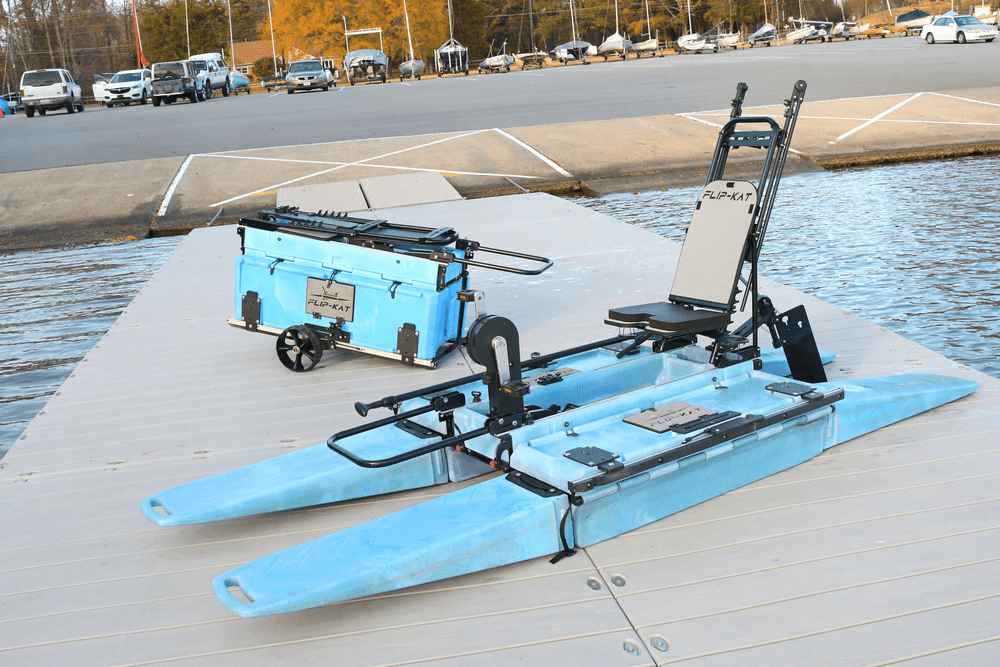
The Flip-Kat® is the first of its kind, offering a custom-designed catamaran-style hull while being completely portable. It folds up to be a portable solution to storage and transport issues that arise with other designs. The Flip-Kat® design is quick and easy to set up, transforming from a compact cube into a full-sized kayak in minutes. The Flip-Kat® has adjustable seating and a pedal drive system, ensuring the best ergonomic comfort on the water. It is also made with super durable materials perfect for various water conditions while maintaining a lightweight design for easy handling.

The Flip-Kat® has many different customization and accessory options, allowing you to create a kayak that fits your needs. If you plan on mostly fishing, you can add rod holders, fish finders, and even a Bipxy motor to get around faster. The Flip-Kat® was designed for the user to make it their own. The Flip-Kat® can be customized to your desires, from leisure to serious outdoor activities.
Benefits for Different User Groups
There are tons of different outdoor enthusiasts who pursue joy in their own way. The Flip-Kat® fits every single passion perfectly. For example, for photographers looking to capture scenic wildlife, the catamaran hull proverbs the needed stability to get that perfect shot. The safest option for seniors who want to enjoy life on the water is the Flip-Kat®. The catamaran hull gives an ease of mind to elders looking for a stable kayak. The pedal drive system also provides more power and maneuverability for all users. For leisure kayakers looking for exercise and fun, the Flip-Kat® is the perfect all-around kayak for any day out on the water.
Portability and Storage
The Flip-Kat® kayak excels remarkably in storage and portability, distinguishing itself as a top choice for enthusiasts and casual paddlers. Its ingeniously designed collapsible structure allows it to be easily folded to a compact size, making it incredibly convenient to store in tight spaces, such as apartment closets, car trunks, or aboard boats. This feature is a game-changer for those with limited storage options. The catamaran hull design creates a space for storing any gear or safety equipment. Whether traveling to a nearby lake or embarking on a distant adventure, the Flip-Kat® simplifies the process, making it effortless to bring your kayak along.
Advanced Features of Catamaran Kayaks
There are a couple of features that make catamaran kayaks much better than other options. On the Flip-Kat®, the pedal-drive propulsion system creates an efficient form of transportation. While pedaling, you will sit in the wholly adjustable and ergonomically designed seat. This is amazing. It lasts for long days and adventures out on the water. The Flip-Kat® is also completely customizable. You can add compatible accessories to enhance your kayaking experience.
Choosing the Right Catamaran Kayak
When deciding what catamaran kayak you want to buy, make sure you consider different factors. These could include the cost, the design, and materials for the kayak brand. There are a few other options, so be sure to do research before purchasing your kayak .
Safety and preparation are paramount in catamaran kayaking: always wear a life jacket, check weather and water conditions, and understand your kayak's features. Carry essential safety gear, inform someone of your plans, and be equipped for emergencies. When navigating, adapt to the environment; in calm waters, focus on technique and balance while in rougher conditions, be mindful of waves and tides, and kayak within your skill level. Training and respecting the water's dynamics are critical to a safe and enjoyable kayaking experience .
Eco-Tourism & Environmental Impact
Embracing eco-tourism in kayaking means choosing sustainable materials, adhering to 'leave no trace' principles, and opting for human-powered kayaking to reduce environmental impact. Responsible exploration requires awareness of the local wildlife and ecosystems, maintaining a safe distance from wildlife, avoiding disrupting natural habitats, and following designated routes to minimize your footprint. Educating oneself about the environment enhances conservation efforts, ensuring a sustainable interaction with nature during your kayaking adventures.
Future Trends and Innovation
Innovations are always coming into the kayaking and outdoor scene. Tons of technological advancements can enhance your experience out on the water, whether that be combining a solar charger with an electric motor or just having advanced fish finders. There are tons of new things that make kayaking more fun.
In summary, the evolution of catamaran kayaks, epitomized by the Flip-Kat® , represents a perfect blend of traditional stability and modern convenience. These kayaks cater to various needs, from fishing and photography to leisurely exploration, while offering remarkable stability and comfort. The Flip-Kat® particularly shines with its portability, ease of storage, and customization options, making kayaking accessible and enjoyable for all enthusiasts. This kayak encourages responsible enjoyment of nature's waterways. With ongoing innovations, the future of kayaking looks promising, ensuring a sustainable and exciting experience for all. The catamaran kayak, especially the Flip-Kat®, symbolizes the seamless integration of human innovation with respect to the natural environment. Order your Flip-Kat® today!
You Found Our Blog! Enter to Win a Flip-Kat™
To celebrate our pre-launch we are giving one lucky individual their very own Flip-Kat™. Enter below!
I Want to Win a Flip-Kat™!
Item Successfully added to comparison list.
Item Successfully removed from comparison list.
At least 2 products are needed to make a valid comparison.
- Canoe Sailing
- Kayak Sailing
- Dinghy Sailing
- Snark Car-Topping Sailboats
- Canoe Stabilizers (Outriggers)
- Rowboat & Porta-Bote Sailing
- Parts and Accessories
- Boats (without sail rigs)
- Motor Mounts
- Portage Carts
- Small Outboards
- Specialty Boats
- Shopping Guide
- Testimonials

Any-Kayak Upwind Sail Kit
(Note: This is a very long page so please keep scrolling down!)
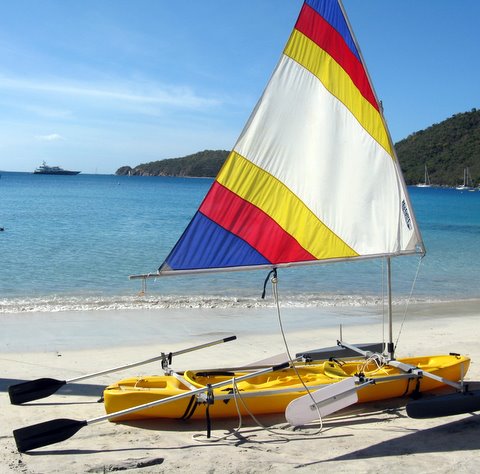
The Any Kayak sail kit includes everything you need to turn your kayak into a real sailboat, capable of tacking into the wind, or sailing across the wind or downwind. Does not require your kayak to have its own rudder, because steering is provided. Straps onto your kayak, so there is no drilling required. Folds to a compact 4-foot-long bundle that you can transport in your car's trunk and store under a bed or in the back of closet. Questions: [email protected] , 978 263 7598. Pictured above with standard 45 SF sail (upgrade to 55 SF sail is available as item 5011), 2 steering oars to make it more convenient to switch steering hands (standard is one), and the upgraded leeboards.
"Jim, Thanks for everything. Very happy with my sail rig, have used it several times already on The gulf of Mexico off Clearwater beach and in Clearwater Harbor." -- Kevin J., buyer of Any Kayak Sail Rig and using it on a Hobie 12 inflatable.
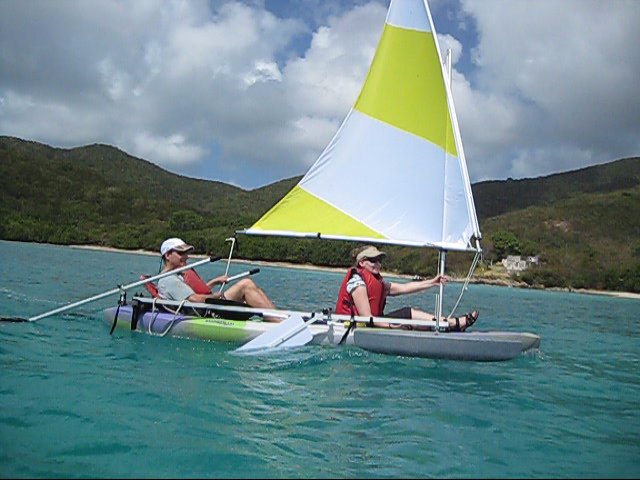
This shot (above) was taken during a trip to the Caribbean. We brought the sail kit and borrowed this ocean kayak from the place where we were staying. This is actually a frame from a video. See the video clips shot that day (unedited) Click Here We had so much fun!
Detailed customer review with photos - click here .
| The Any Kayak upwind Sail Rig with Stabilizers Upwind sail rig for almost any kayak -- inflatable or rigid; also fits the Stearns inflatable canoe, or the Tote-N-Boat folding canoe. Attaches using straps. Makes your kayak into a complete sailboat, including leeboards, mast,sail, spars, rigging, and steering. How to sail instructions for beginners included. Includes hydrodynamic outrigger stabilizer floats to keep you upright (item 6020 is same rig without floats). Long aluminum side rails help to make inflatables more rigid and connect the front assembly to the steering oar assembly behind you so that no drilling into your rigid kayak is required on noninflatables. If you're going to use it on a rigid kayak or Tote-N-Boat, just drop us an email when you order so we give you the right version: [email protected]. This kit has a lot in common with our other sail kits, so if you want to be able to use it on regular canoes, kayaks or inflatable rafts, you'll only need a few extra pieces. Email or call us and let us know what versatility you want and we'll set you up with the right additional pieces. Length of standard side pieces is adjustable from 5 to 7 feet fit large and small-cockpit kayaks. Different length ranges available by request. For accessories, upgrades and other models see our . The additional shiping cost to UK, Western Europe, Japan is item 1999 . Like all our sail rigs, this model folds and comes apart for transport and storage. With item 5092 leeboard upgrade, rig (excluding stabilizer floats) fits into compact bag just 7 inches x 9 inches x 47 inches (item 3012)! Rig and stabilizers, even with standard leeboards, fits in our #6005 bag, which is 12" x 10" x 48" (like a set of golf clubs). Standard mounting method is by straps and it works great. If you prefer having a bolt-on connection, order 2 pair of our kayak adapters and deck brackets ($50/pair) for this rig, or consider our item 6025 bolt-on rig with no side bars. Hydrodynamic stabilizer floats, leeboards, 1 steering oar, 45 SF nylon sail included. Same rig without stabilizers is item 6020. Upgrade to larger sail, with taller & stronger mast by adding item 5011 to your rig purchase. | Put into cart to see price (you can always take it out again) |
| Any Kayak upwind sail rig with inflatable stabilizers Straps onto just about any kayak and has inflatable stabilizer floats (amas) to help prevent capsizing. Adjustable for kayaks of different lengths and widths. Complete sail kit including sail, mast, frame, rigging, leeboards and 1 steering oar. Carry bag additional (item 6005). Same rig with rigid stabilizer floats is item 6004 or no stabilizers is item 6020. The advantage of rigid stabilizers over inflatable ones is much lower drag if submerged by strong winds. But under most conditions the inflatables work very well. And they are more portable Please send us an email after ordering width and type of kayak. Folds to compact bundle less than 48 inches long. | Put into cart to see price |
Here is the same rig on an inflatable kayak (Innova Helios tandem):
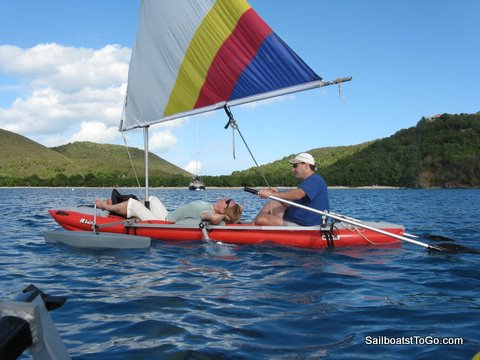
Click arrow in center of picture below to launch video. Turn up your sound and kick back!
Here is the Any Kayak Sail Rig on a sit-inside kayak. More photos below this video so keep scrolling down after watching second video.
See what you can do with colors:
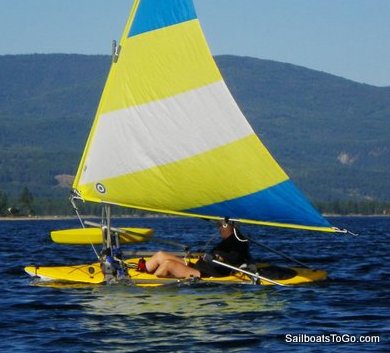
Shown with color coordinated stabilizer floats and Neil Pryde sail (at left). We have yellow, red, gray and mango floats and wide variety of sails. At right above, see oversized 66 SF sail in color scheme B with mango floats. Below, see 55 SF sail in color scheme D on a Sea Eagle 330 inflatable kayak:
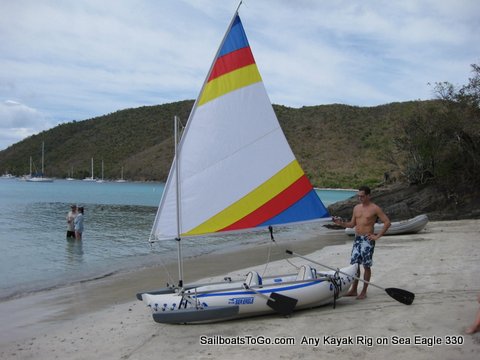
Sitting in a front yard in Vancouver Canada we see a customer's tandem sit-in kayak with the 6004 rig (he didn't put on the stabilizers nor the leeboards for this photo, but he has them) and the larger 55 SF sail and heavy duty mast. He writes in August 2013: " You probably don’t remember me, but I purchased one of your systems in August of ’09. I live in the Vancouver area. I purchased the model 6004, with all the extras including stabilizers, leeboards, etc. I also upgraded to the 55 sq ft sail. I have been very happy with everything." Later on the phone he related that he brings the kayak and sail kit on his large cruising sailboat and then when he's on a mooring in some harbor he sails around off the big boat in his kayak with this rig.
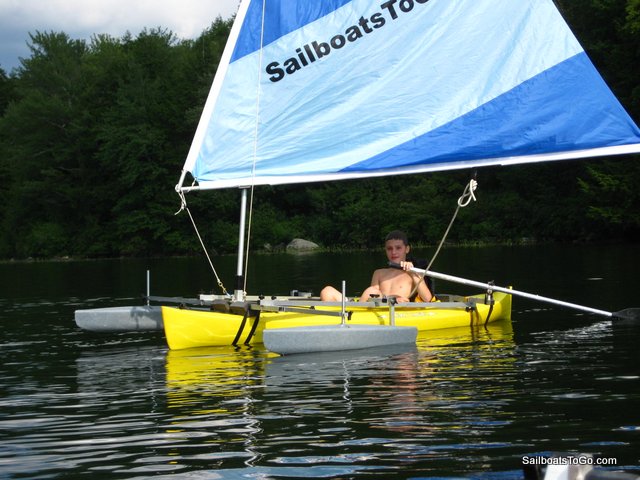
Here is the 6004 rig on a little 10 foot solo sit-inside kayak, illustrating its extreme adjustability. You can get this same 2-tone blue sail without the logo. Sail B we call it.
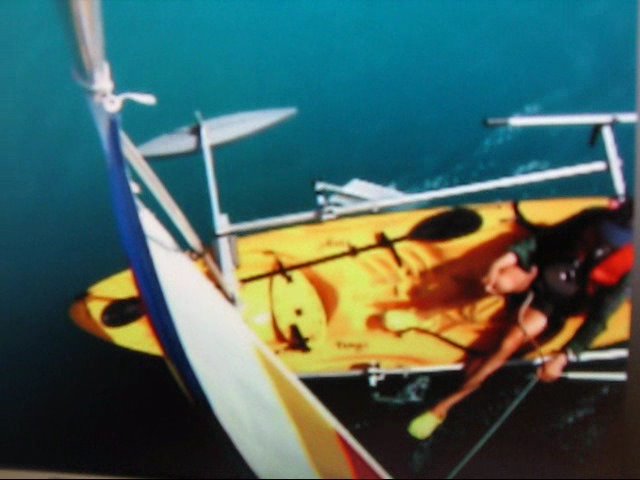
This was another case of borrowing a kayak at our destination to go with the sail kit we had brought along. To get this shot, we attached a small camera to the top of the sail pointing down and shot video, then picked a frame from the video to make this still.
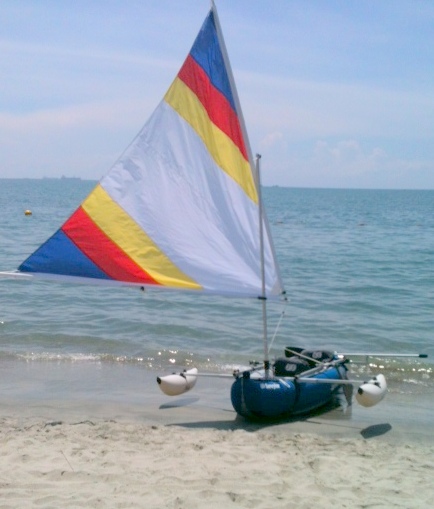
Above: SailboatsToGo "Any Kayak" sail kit with inflatable stabilizers (item 6001) on a Sevylor Colorado inflatable canoe.
Below: Assembly and Mounting How-To Video:

STABLE KAYAKS AND MICROSKIFFS MADE BY WAVEWALK
microskiff, stable kayak, portable boat
Personal Catamaran
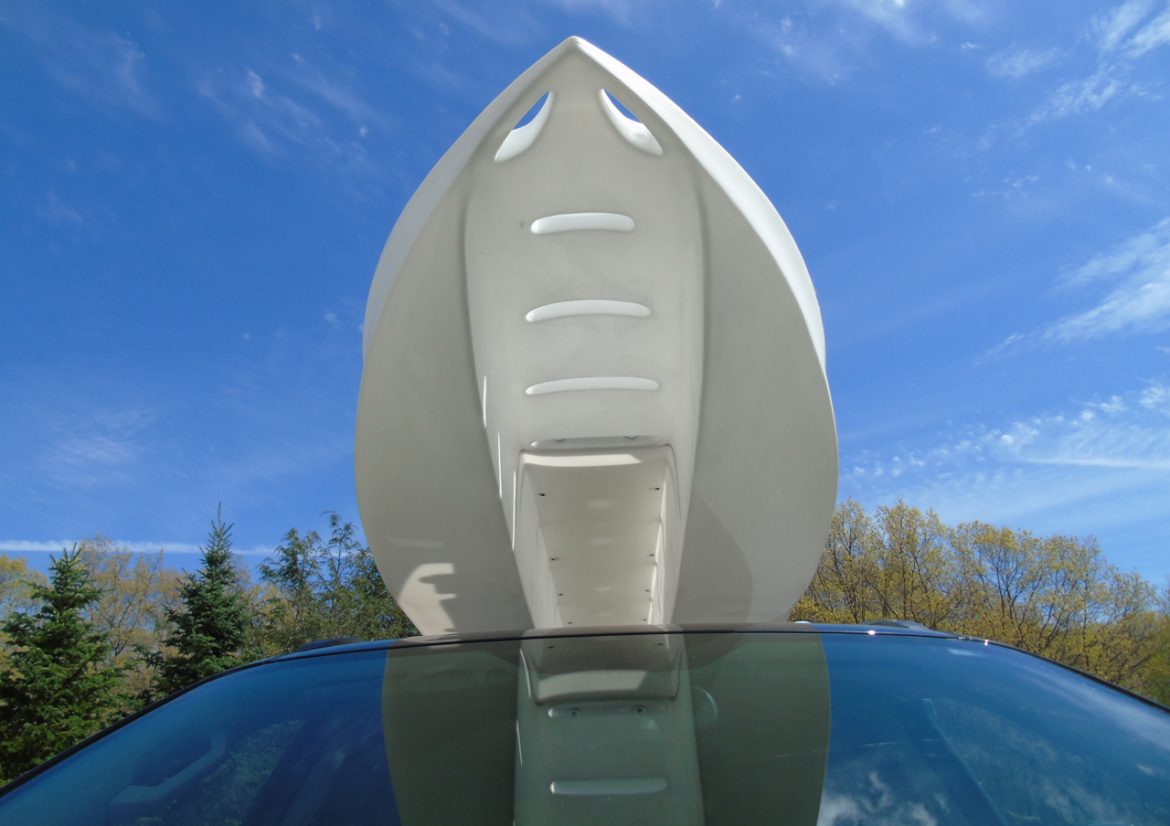
What is a Catamaran?
Definition: A Catamaran, a.k.a. ‘Cat’ is a twin hulled watercraft that features two slender, parallel hulls of equal size, and an upper structure that holds them together at a distance from each other. This structure makes the typical catamaran a geometry-stabilized craft, that derives its lateral stability from its wide beam and the distribution of its buoyancy along its sides. The catamaran’s two hulls combined often have a smaller hydrodynamic resistance than monohulls of comparable size, and therefore require less propulsive power. Catamarans range in size from small sailing boats and motorboats to large ships and ferries. The structure connecting a catamaran’s twin hulls can vary from a simple, lightweight frame to a bridging superstructure, namely deck from which the catamaran is operated, and can be used for carrying freight and passengers.
Are the Wavewalk 700 and S4 Catamarans?
Both these Wavewalks are catamarans since they feature two distinctive hulls, but they are not catamarans in the traditional sense: The Wavewalk design is based on a proprietary (patented) invention – a new type of small watercraft. This patent is entitled “Twin Hull Personal Watercraft”, which is revealing of the fact that a Wavewalk is meant to serve one person, or a small number of persons, and closely interact with them. A Wavewalk is designed around the person and for that person, and it offers them the optimal means to balance themselves. Wavewalk and user are an integrated system that can achieve the most stability in a watercraft of similar size and even bigger ones. Unlike a typical catamaran, a Wavewalk is narrow – It is slightly wider than its operator, similarly to typical monohull paddle craft such as kayaks and canoes. The user of a Wavewalk operates the boat neither from one of its hulls nor from the top of a deck-like structure that bridges the hulls of a classic catamaran. Instead, the Wavewalk user operates it from within, with a leg in each of the boat’s two hulls. The user’s feet rest firmly on the bottom of the hulls, below waterline, namely as low as possible. And this is the main difference between a Wavewalk and a typical, wide catamaran – The Wavewalk is a smaller and narrower watercraft whose design offers a hull for each of its user’s legs, combined with a longitudinal saddle seat, as means for them to balance themselves effortlessly, intuitively, and with the maximum effect. In sum, the Wavewalk is different from a typical catamaran in that it is not a pure form-stabilized boat, but one that combines more than one feature and approach in order to maximize stability*
Another difference between the Wavewalk and a typical catamaran is the form of the structure that connects its twin hulls. This structure is called the Saddle, because it resembles the type of seat found in personal watercraft (PWC) a.k.a. ‘Jet-Ski’, snowmobiles, and all-terrain vehicles (ATV), all of which are high-performance personal vehicles.
If it’s a catamaran, can the Wavewalk be a kayak, a boat, or a PWC?
Thanks to the fact that the S4 features two totally distinct catamaran hulls, the authorities, namely the US Coast Guard, officially classify the Wavewalk S4 as a Multihull Boat. The reason the S4 is classified as a boat and not a kayak is the fact that Wavewalk, its manufacturer, set the max recommended power for it to 6 HP, which is beyond the power range allowed for motorized kayaks its size. However, the W700 is classified as a kayak because Wavewalk set the maximum recommended power for it to 3 HP, which is within the range allowed for kayaks its size.
The Wavewalk design is considerably more stable than kayaks are, including the wide fishing kayaks. It tracks better than kayaks, and paddles infinitely better in strong wind, which is why it does not require a rudder. The Wavewalk also offers much more storage space. But most importantly, unlike monohull kayaks that force their users to paddle seated in the notoriously uncomfortable L posture, the Wavewalk is back pain free , since it offers it users to comfortably ride its ergonomic saddle, with a leg on each side of their body.
The unique combination of maximal stability and better ergonomics makes the Wavewalk such a perfect match for a motor.
A personal watercraft (PWC)?
Riding the saddle of a motorized Wavewalk® S4 at a speed of 17 mph is an exhilarating sensation that may remind the driver of a PWC, but the latter type of watercraft features much more powerful engines, and can go much faster than the S4. Additionally, PWC are designed for instant full recovery in case they capsize and their user survives… which is not the case with a motorized Wavewalk.
Even a small boat is still much wider than a kayak, or canoe, which is why it’s practically impossible to paddle a boat to any meaningful distance. This extra width gives a boat a significant stability advantage over kayaks and canoes, and typically, a normal size person can stand on one side of a boat without tipping over. But a normal size person can do this in a Wavewalk® 700 too, and this unique fact places the Wavewalk® 700 in a class of its own – a kayak that offers the stability of a small boat. Motorized, a Wavewalk® 700 offers the stability performance of a small boat, on top of its unique and unrivaled performance in terms of mobility, comfort, storage space, etc. As for the S4, it is considerably more stable and seaworthy than other boats of similar size.
What about A canoe?
Canoes can be very big, and transport up to dozens of passengers. The popular North American recreational canoes that measure up to 17 ft in length can take 3 to 4 adult passengers on board. While Wavewalks work perfectly with single-blade (canoe) paddles, both solo and in tandem, they can carry less payload than large size canoes do. However, a Wavewalk tracks better than a canoe does, and unlike canoes, it is easy to paddle in strong wind .
… and a motorized canoe?
A motorized square-stern canoe performs much like a lightweight dinghy, and as such it doesn’t work very well as a dedicated paddle craft, namely a canoe…. In addition, it is usually less stable than a typical dinghy, which is wider. Thanks to its slender, parallel twin hulls, the Wavewalk® 700 tracks better than a motorized canoe, it’s more stable, and being narrower it paddles better as well. Driving a Wavewalk® 700 is easier too, thanks to the ergonomics of its saddle, and the fact that the motor is located closer to the middle of the boat, away from its stern, which improves balance.
In the sense that it works well as a micro skiff, namely a small, flat bottomed boat used for fishing in flats, estuaries and protected bays, yes, a motorized Wavewalk® 700 is an ultra lightweight, trailer-free micro skiff, and it can even be outfitted with a bow mounted electric trolling motor powered by a battery fed by the alternator in a small stern mounted outboard motor. This said, its form is very different.
The Wavewalk S4 is more seaworthy than other micro skiffs, as well as more versatile since it works well as a paddle craft, so unlike other microskiffs, it cannot get stranded in shallow water and ebbing tides.
* Interestingly, the crew of competition sailing catamarans has to relocate from one side of their boat to the other in order to help stabilize it.
3 thoughts on “Personal Catamaran”
An Observation:
The USCG designation of kayak is beneficial to Wavewalk purchasers but the unique multi-hull configuration does present some identity issues with conventional yak owners.
IMHO, most kayaks are uncomfortable for extended use, relatively unstable, and soak your butt. When a newer design solves those issues, there may be some envy issues… Like, misery loves company.
It appears the best market of the W500 & W700 boats is for people who prefer to be happy on the water regardless of what they enjoy doing. Whether you fish, photograph, snorkel, paddle, motor, or hot dog standing up planing on a choppy lake with your joystick in hand, it is pretty hard to be unhappy in a Wavewalk vessel. Simply replace your aching back, wet butt, aggravating expense and maintenance with simple joy.
Is there a better reason to own a magic boat?
The Wavewalk is a magic boat, but the kayak market is crowded with manufacturers, importers, and vendors, and the average retail price of a kayak is around $550… Also, when someone thinks “I want to paddle a kayak” or “I want to fish from a kayak” the image they have in their mind is that of a conventional, monohull kayak.
Thus, it becomes our challenge to show that the twin hull W-design is a better alternative. I know you’ve been doing this for quite some time while making design improvements and expanding the product line.
Recently, I listed two fiberglass boats on Craigslist:
The 20′ Shamrock and trailer fixer upper generated a lot of calls at $1,500 but the sale came from putting it on the street. It was the perfect affordable father/son challenge for a neighbor of mine.
The deckless 35′ open catamaran hull listed for six grand at our local boatyard sold very quickly based upon a great open ocean design that could be completed for whatever need someone might have. I got wonderful calls from people with both vision and cash.
It is now destined to be a mother ship for a jet ski business in Miami.
Finding happy people with vision and cash to purchase a better kayak design that suits their needs is not impossible. But, it may be a greater challenge in this particular election year.
The only endorsement here is for choosing a Wavewalk.
Time to spread more joy…
Leave a Reply
You must be logged in to post a comment.
Home » LIST of WOODEN BOAT PLANS – By Michael Storer » Add a Sail to a Canoe or Kayak, A Plan for a Drop-in Sailing Rig
Add a Sail to a Canoe or Kayak, A Plan for a Drop-in Sailing Rig
One Drop in Rig for Trevor’s family has been used to make an instant sailing boat from a kayak then two different canoes over a 12 year period shows enormous versatility. Video below shows it really covers ground and is for going places. Definitely not a toy but turns a canoe into a real sailing machine
- Sail Area – options from 1.64 sq m (17.6 sq ft) to 3.34 sq m (36 sq ft) – only requires lengthening the mast
- Mast, Yard and Boom length – 1.65m (5ft 5ins)
PDF Plans by email – $24 Paper Plans – Please discuss with one of our Regional Agents
We make all three sail size options for the Drop-In Sailing Rig.
Quality 36 sq ft canoe and kayak sails at excellent prices available from our friends at Duckworks USA.
Or by Direct Order to us at our sailmaking business Really Simple Sails .
We have several Designs for Sailing Canoes.
From focus on paddling to focus on sailing.
Our different sailing canoes have different mixes of sailing and paddling ability. Some use existing canoes and add the sailing function. For an overview see our page about practical choices about performance, handling and advantages and disadvantages of different sailing canoe concepts. Link – Four Sailing Canoes in Plywood and One Outrigger Canoe

Three Types of Canoe and Kayak Sail Rigs
Trevor’s original kayak with the original small rig.
Sailing Rigs for Canoes and kayaks usually break into three groups.
1/ simple canoe and kayak sail rig for basic sailing.
With this rig it is possible to add sailing ability to go with and against the wind.
2/ Canoe and kayak sail rigs for downwind only
There are auxiliary canoe and kayak sails for (usually) seakayaks that are used to propel the boat downwind only to save paddling effort and cover serious ground – you do have to paddle back though :)
3/ Full performance sailing rigs allied with suitable hulls
There are rigs to give a canoe higher performance like all round sailing dinghy speed. (see my BETH design).
This Drop in Sailing Rig for sailing all directions
A rarely seen variant is something in between – a no-fuss canoe or kayak sail rig that does not make the boat hard to handle but provides enough power to sail reliably upwind and down. It should include a sensibly sized leeboard so windward progress is reasonably efficient. It is important that the leeboard is of a reasonable size – boards much smaller than this have poor windward performance.
This rig is the third type. It does not offer the highest performance possible, but it is small enough to fit inside the boat when not in use. The leeboard necessary for upwind sailing is removed at the same time as the mast support leaving the boat ready to be used as a pure paddling canoe.
A video from Paul Helbert who wrote the piece below. it is me sailing. Initially on a broad reach and then winding up upwind in a gust. Fun sailing!
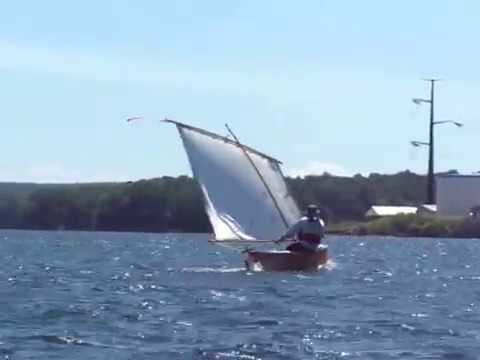
Drop in Sailing Rig – 1 rig, 10 years and 3 Boats
Recently I received an email from Trevor Killmier who purchased the first set of the plans 10 or more years ago to add a kayak sail. I’ll let him tell the story . . .
Hello Michael, You may remember me from way back. I think we last corresponded back in 95/96. You designed a drop in sail rig for a fibreglass canoe we had.
Convert canoe or kayak into a sailboat. Drop in sailing rig: storerboatplans.com I was delighted to see a photo of it on the Duck Flats website and I’m pleased that you’re marketing the rig again because I get many inquiries about it.
We had a lot of fun out of that sailing canoe (picture of the original boat the rig was fitted to right – the rig was built by David Wilson of Duck Flat) but I think in retrospect the hull was quite unsuitable for sailing. It had a very strong weathercocking tendency and I think I wrote and told you that I managed to hurt myself sailing it. (As it turns out, that probably would have happened to me anyway in some other way because of an illness I had at the time and which I still have.)
Murray River. convert canoe or kayak into a sailboat. Drop in sailing rig: storerboatplans.com
I eventually added a rudder and was able to sail it myself again. My son also taught himself to sail in it and had an enormous amount of fun. However, it was impossible to right after a capsize unless you were able to stand up and so I looked for a more suitable hull. I had the wooden boat plans of John Bull’s Peterboat sailing canoe and had started building one of those before I hurt myself. Some years later, I was able to resume that construction and completed it, launching it in 98.
The plans call for a 40 ft.m² lateen rig but I sail down at Clayton mostly and always thought that was just too big. So, I simply transferred your Kayak Sail rig across to the new boat and it has proved perfectly satisfactory. I have since added a small tie on jib and an outrigger and have been sailing regularly since 98. (picture left is launching day)
I am now building John Bull’s little Pete — a single seat version of the same canoe — and will transfer the rig over to that.
Clayton Bay. convert canoe or kayak into a sailboat. Drop in sailing rig: storerboatplans.com I regret not being in touch with you earlier simply to convey how much pleasure I get out of this boat.
I guess I’m a minimalist at heart but I’m sure there are many people out there with much bigger boats, far heavier and more expensive, who just don’t get the amount of fun out of their boats that I do out of mine. The only drawback is that I sometimes don’t get to sail it because I spend so much time talking to interested onlookers! (picture at right canoe at Barmera)
Rosemary and I have a van in the caravan park at Clayton and another semipermanent occupant of the park has told me that he wants to build one. I haven’t seen him for a while but have told him that the rig is yours. Now I’ll be able to direct him to the site.
I have some photographs of the rig on the Peterboat and if you would like to see them or even use them for marketing purposes, I would be happy to send them to you.
Trevor Killmier.
—– Original Message —–
Wow – how lovely to hear from you Trevor!!!
Your letter is EASILY one of the nicest things I have read in a while. When I design something it is often the case that I send the plans off, have a bit of correspondence while the boat is being built etc.
BUT … to get a letter after 10 years showing the damn thing works, that it has been moved from boat to boat – AND MOST IMPORTANTLY – has fitted into someones lifestyle so perfectly is just the best thing.
Thankyou so much!
If there are photos available of the different incarnations of the rig I would love to see them – perhaps to scan them and put on my website.
Again thankyou for getting in contact!
Best Regards Michael
Thanks Michael, Yes, the damn thing really works!!!!! And works so well for me. I’ll hunt out some photos, scan them and forward them to you. I know there are photos of the rig on both the yellow canoe and the Peterboat so I’ll look for a selection.
I’m glad you’re still interested in this idea – I just can’t understand why more people don’t add a rig to their canoes. Instant sailing boat: instant fun. Have you tried it on the Eureka design? Regards, Trevor.
Note: I think the boat in the photo has the sail hoisted a little bit too high (compare the photos from Trevor Killmier to the drawings). Keeping it a bit lower will reduce the heeling force (less chance of capsizing) and also reduce the load on the mast. Moving the halyard a little further back on the yard (the wood along the top edge of the sail) will cock the boom up so it won’t hit the user’s head. That’s the designer’s (my!) opinion, but Trevor has 10 years of experience of the rig with a series of different boats in a range of different conditions – so who am I to argue! :-) I would suggest setting the rig up like the drawings to start with, but if there are problems with head clearance, move towards Trevor’s setup.
Notes from the Plan
This rig is designed to drop into a paddling boat, whether canoe or kayak. As far as possible all the gear is removable from the boat except for the mast step and three unobtrusive fittings that will not interfere with the paddling function. The blue jibsail in some of the photos is not part of the plans.
Many people have a paddling boat and would like to gain a feel for sailing at moderate additional cost. The objective of this rig is to add the ability to sail to the function of an existing boat without interfering with its existing paddling performance.
If steering with a paddle take particular note of the section at the end on sailing the kayak. It explains how to adjust the leeboard to minimise the steering loads.
A reefing point has been specified in the drawings to enable the sail area to be reduced in marginal conditions. It is not expected that the boat will be able to sail upwind while reefed, though it will still be able to sail well downwind.
I would recommend doing some practice capsizes in safe waters on a warm day to see if you can rescue yourself or if you need outside assistance.
The spars and leeboard have been sized to fit inside most boats or the leeboard can be swung forward to be out of the way of the paddler should the boat have to be paddled home.
MAKE SURE THE BOAT IS EQUIPPED WITH AND THAT YOU WEAR APPROPRIATE SAFETY EQUIPMENT. KEEP AN EYE ON THE WEATHER.
Another factor for consideration is that canoes and kayaks can be very fast under sail – particularly with the wind coming from astern. Take care not to go excessive distances from your home base without realising and setting yourself up for a very long paddle home. A good way to avoid such problems is to start toward the direction the wind is coming from – then you will be able to enjoy a quick sail home.
A Review on the Drop in Canoe Rig from Paul Helbert in the USA
Canoe with sailing rig
Yee Haa! What a hoot! Winds yesterday afternoon were Force 3 to 5 with plenty of gusts to Force 6 or more. Sunny and temperatures dropping through the forties. Lake water cooled by snow melt. The canoe sailed more predictably than under lighter conditions. I’m ready to replace temporary c-clamps (g-cramps to you) with screws and cleats.
I am highly pleased with the performance of Michael Storer’s drop-in canoe sailing rig.
The little balanced lugsail, all the spars, the leeboard and the integral mast partner and leeboard brace are from his drop-in canoe sailing rig. The only thing I changed is that I made it so that the pivot point is below the gunwale instead of above it (*) and I extended the foil stiffener above the top of the leeboard to provide a handle. I added an articulated extender (stick & bolt) to that and am using nut tightness to hold it in position…will probably harden that up with a line & cleat in future. In these windy conditons she seemed to sail best with the board downabout 15-20 degrees off vertical.
The rigging is all MIK’s. The only modification I made to the hull (16 ft ABS Esquif Presage canoe) was to glue in a mast step. I used small rope loops tied to thwarts instead of the hardware specified. I may eventually stiffen those up a bit but the lines ran smoothly today.
Canoe Sailing Rig – drop in with integral leeboard I love how easily I can set up and take down this rig. I just throw the bundled up sail and spars and the leeboard into the back of the van. It is not even necessary to remove the clamp-on brace as it clears my roof rack with ease.
(note that Paul made his own sail out of Polytarp. He is a PDRacer veteran, so is very comfortable making his own sails.
This was my fifth or sixth outing with this rig and the windiest by far. I have tweaked things each time and am now pretty satisfied with it. I only needed to paddle steer a little since I have now got the overall balance about right. I did not need to do much leeboard adjustment today, either…just raised it a bit while running and back down on close reach. My weight forward to initiate a change of tack, back once throught he eye of the wind.
When I first got the plans I was a bit troubled that the sail was so small (17 sq ft). Someday I may make a bigger rig, but this rig makes sailing in strong gusty winds feel safe, and with eight foot spar lengths it is easily stowed in the canoe. Still exhilarating but not scary. For me that is perfect for winter. The flex of the spars is such that the gusts depower the sail just enough; and then she scoots as the gust blasts on across the lake, the spars straighten and the full draft returns to the sail. I’ll get some more photos one of these days but there was nobody at the lake today to handle a camera. I had my drysuit on but never felt anywhere near needing it.
The surface of Lake Arrowhead, near Luray, VA, does not get much chop because it is protected from the wind by the surrounding hills. Its small size (40 acres) also keeps large waves from building. The lake lies in the lee of a couple of small mountains which cause the wind mix and swirl when steady stiff breezes can be observed out on the open valley floor. Still, it was a great workout. I was on the water a bit less than an hour and a half.
Quit when the sun was five degrees from the horizon. The lake is thirty minutes from home, so I didn’t blow off the whole day.
(*) Now to the point for PDR builders: This morning I was getting ready to repair some nicks on the bottom of the leading edge of the leebard when I noticed that the leeboard bracket had broken and was only being held by three screws. MIK’s design called for the bracket to be made with the pivot above the gunwale and I wanted it lower.
My change caused me to leave out two gussets and that lack of support is why it failed. MIK does not over engineer. If you see a brace in one of his designs it would be best not to omit it. It is very likely there for good reason.
Paul has since fitted the rig to a new protoype of the Quick Canoe.
— Paul Helbert Father of “The Canoe Guru” http://thecanoeguru.com/
A bigger rig – 36sf
From here Paul Played with bigger rigs. The 36sq ft mainsail was his. He even sailed the uber-narrow Quick Canoe with the 36sq ft sail up front and the 17sq ft sail on the back as a mizzen.
Nothing ever broke and he tried it on a wide range of canoes
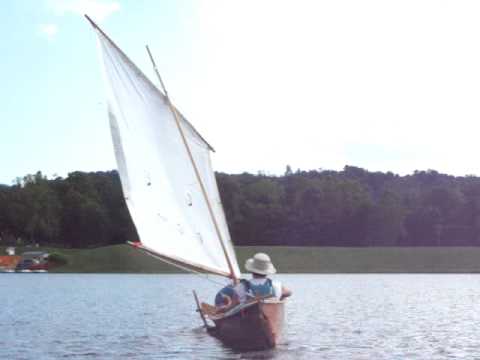
On my one visit to Paul’s neck of the woods I had a great sail around with no rudder. Just changing the angle of the leeboard to point up or bear away to tack or gybe.
We eventually made the 36sf sail available through Duckworks .
Other links: A FAST SAILING CANOE – that is easy to build. Another FAST SAILING CANOE – that is easy to build. FIBERGLASS CANOE (90lbs – 42kg) vs Plywood canoe (42lbs – 19kg) – and the ply canoe is less maintenance Materials list for Drop-in Rig (PDF file)
Log in or Sign up
You are using an out of date browser. It may not display this or other websites correctly. You should upgrade or use an alternative browser .
info on cat. conversion to two Sm. canoes / kayaks ?
Discussion in ' Multihulls ' started by junkman , Dec 4, 2009 .
junkman Junior Member
I'm playing with the idea of a catamaran that can be dismantled . The two floats placed beside one another and bolted down on top the frame that holds them together, (in the water) and then car topped. The other part is to make the two floats wide enough to use as two individual canoes or kayaks or the like, with out making them to bulky and slow for cat sailing. The purpose is to have fun with a little efficiency but focus on versatility. Some where between a rabbit and a turtle. I assume I'm the very first guy that has come up with this idea .... ha ! Any related threads or sites would be greatly appreciated. Thanks in advance,
BWD Senior Member
nothing new under the sun, they say, but good luck with your "Trabble." Some stuff to check for ideas/issues of interest if you haven't already: http://homepages.paradise.net.nz/garyd/ and this blog for a start: http://sailnaway.blogspot.com/searc...-max=2007-01-01T00:00:00-05:00&max-results=20 NCSU guys that made 2 dierking outriggers and operated them sometimes as a cat (at east once, anyway). Can also be done with kayaks. Maybe you should also look at Chris Ostlind's website, several things there might be compatible with your idea: http://www.lunadadesign.com Have fun.
bill broome Senior Member
look into sailing canoes. there's two kinds really: canoe with a small sail, for fun and a bit of help with paddling is easy to organize. then there's the serious kind with a bigger rig and a hiking plank. this is basically a small trimaran without those sissy ayas. two canoe catamarans are possible, but they are flat bottomed and will slap in a chop. a big double kayak has a better shape for sailing, i'd try a tahitian sailing canoe plan first: it just needs a cross platform at the mast foot, where the crew keeps the boat upright by moving in and out on the windward side. put a very small aya on one side to keep the boat up when tacking. both sides if you prefer less drama. big drawback is pretty much need two crew.
catsketcher Senior Member
Go proa The cat will be slow and have insufficient buoyancy or the kayaks won't be stable enough to sit in and too high. Look up Gary Dierking and look at his outrigger canoes. Good for paddling and for sailing
hoytedow Carbon Based Life Form
junkman said: ↑ I'm playing with the idea of a catamaran that can be dismantled . The two floats placed beside one another and bolted down on top the frame that holds them together, (in the water) and then car topped. The other part is to make the two floats wide enough to use as two individual canoes or kayaks or the like, with out making them to bulky and slow for cat sailing. The purpose is to have fun with a little efficiency but focus on versatility. Some where between a rabbit and a turtle. I assume I'm the very first guy that has come up with this idea .... ha ! Any related threads or sites would be greatly appreciated. Thanks in advance, Click to expand...
muddin redneck DO IT IN THE MUD!!!
Double Canoes For A Cat here are a few pics i found just the other day that i thought were just plain cool and used them as my computer background. it may give yoiu an idea on how to make you boat. the boat could be widened if you wanted to. hope this helps
Attached Files:
2canoe2.jpg.
Looks simple enough to build two p-redesigned hulls and mate them. If I can find a shape that lends itself to both needs. It look as the shapes will want to be low and wide- slow and choppy or high and narrow-difficult to row and balance. Perhaps not a rabbit or turtle, a "platypus". Ill look at all and see what comes of it. I'm not in a hurry as it will be about a year before I can hit water on the west coast. Something like a kayak sounds interesting but figure Tahitians have been at it some time, hull shape any way. Ill check out the sites Thanks Guys. for the information.
dstgean Senior Member
junkman said: ↑ I assume I'm the very first guy that has come up with this idea .... ha ! Any related threads or sites would be greatly appreciated. Thanks in advance, Click to expand...
Chris Ostlind Previous Member
muddin redneck said: ↑ here are a few pics i found just the other day that i thought were just plain cool .... Click to expand...
junkman said: ↑ ... The purpose is to have fun with a little efficiency but focus on versatility. Some where between a rabbit and a turtle. I assume I'm the very first guy that has come up with this idea.... Click to expand...
- Advertisement:
Your photography is nice and legible,very good job on that and your building progress. As I'm browsing these boats I find that I would really benefit from building bigger than Id planed. Me thinks any thing one dose should be a multiple design unless one truly needs specifics and should not escape the mind, a light boat would be ultimate. (speaking as a boat novice) I didn't think of adding flotation to single hull, when separating the Cat , but this would allow one to make the hulls very tall yet still get to use as canoe and such........nice. Ive been looking for some shape in between but have the jitters going back and fourth. I had thought of making something like the Lars, http://www.duckworksbbs.com/plans/jim/larsboat/index.htm maybe adding some height and beefing it up. Ive changed my mind again! As for sail power if you haven't visited this site, very interesting http://www.garryhoyt.com/id36.html I wonder if this could work with a double hull. Looks very innovative check out the 360 turn around!. Good Video.
Info needed Simpson 8.3m catamaran?
Inquiry for information from experienced boatbuilders and boat designers
Adrian Rogers design info
"Cliffhanger" 42' Lex Nicol tri. I have just bought it, looking for info
Looking for 26' normon cross info
Proud owner of a TT680 but need more info/plans
Simple Info!
Seawind 24- Looking for owners manual/info
Buccaneer 33 Water stays, placement, construction, reinforcement?
Seeking info on this 12' Fiberglass Proa w/ Barefoot 12 sail insignia
- No, create an account now.
- Yes, my password is:
- Forgot your password?

Cart is empty
- Comparison list

- Select Product Category
- 8.6' Inflatable Dinghy Boats SD260
- 9.6' Inflatable Dinghy Boats SD290
- 11' Inflatable Dinghy Boats SD330
- 11' Inflatable Boats SD330W
- 11' Heavy Duty Boat XHD330
- 12' Inflatable Boats SD365
- 13' Inflatable Boats SD385
- 13.8' Inflatable Boats SD415
- 14' Inflatable Boats SD430
- 15' Inflatable Boats SD470
- 16' Inflatable Boats SD488
- 18' Inflatable Boats SD518
- 9.6' Fishing Inflatable Boats FCB290
- 14' Heavy-Duty KaBoat FKB430
- 10' Heavy-Duty Boat FB300
- 12' Heavy-Duty Boat FB365
- 13' Heavy-Duty Boat FB385
- 14' Inflatable Heavy-Duty Boats HD430
- 9.6' Inflatable Slatted Boats SB290
- 9.6' Inflatable Budget Boats CB290
- 11' Inflatable Budget Boats CB330
- 12' Inflatable Budget Boats CB365
- 9.6 Azzurro Mare Inflatable Boats AM290
- 11 ft Azzurro Mare Inflatable Boats AM330
- 12' Inflatable KaBoat SK396
- 14' Inflatable KaBoat SK430
- 15' Inflatable KaBoat SK470
- 13' Heavy-Duty KaBoat SK385XL
- 15' Heavy-Duty KaBoat SK470XL
- 16' Heavy-Duty KaBoat SK487XL
- 14' Performance KaBoat ZK430
- 12' Folding Aluminum KaBoat KA365
- 11.5' Frameless Cataraft CR350
- 13' Frameless Cataraft CR385
- 12' Light Inflatable Rafts RD365
- 12.5' Large Fishing Raft FR380XL
- 13' Heavy-Duty River Inflatable Rafts HRD385
- 9.6' River Inflatable Rafts RD290
- 12' River Inflatable Rafts RD365XL
- 13' River Inflatable Rafts RD385
- 12.5' Heavy-Duty Fishing Raft FR380
- 13' Whitewater Inflatable Rafts AMR385
- 8.6' Portable Inflatable Kayak
- 11' Inflatable Hybrid SUP Kayak
- 13.5' Paddle Board / Kayak
- 12' Motor Board SUP Skiff
- 12' Budget Inflatable Kayak IK365
- 13' Fishing Motor Board SUP
- 12' Extra Heavy-Duty Fishing FIK365
- 13' Fishing Light Kayaks FK396L
- 13' Fishing Inflatable Kayaks FK396
- 14' Ocean/River Inflatable Kayaks OK420
- 12' Inflatable Pedal Kayak PK365
- 12' Inflatable Fin Pedal Kayak FPK365
- Compact Pedal Drive
- Electric Fin Motor For Kayaks and SUPs
- 9.6' Cargo Trailer Boat
- 11' Inflatable Catamarans MC330
- 12' Inflatable Catamarans MC365
- Saturn Dry Bags
- Inflatable Fenders
- Floating Dock Container
- Inflatable Floating Dock
- 3HP Parsun Electric Outboard Motor
- 55 Lbs Electric Trolling Motor 12V
- 1HP Light Electric Motor 12V
- Hangkai 4HP Outboard Motor
- Hangkai 6HP Outboard Motor
- Rudder System for Kayak
- Central Console For Boat
- Seating Frame For Boats, KaBoats, Rafts and Kayaks.
- Rowing Frame for 2 People
- Aluminum Fishing Chair
- Deluxe Sport Fishing Kayak Seat
- High Pressure Hand Pump
- Digital High-Pressure Electric Pump w/Battery
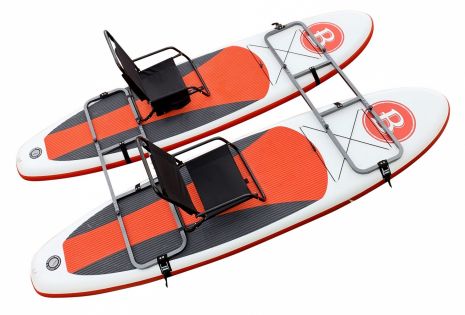
Catamaran SUP Frame
New product.
- Description
- More Pictures
- Attachments
Aluminum Catamaran Frame for Inflatable Paddle Boards.
Convert 2 paddle boards into an electric or sail catamaran..
Also can be used to install electric motor on single kayak, canoe or paddle board. See pictures for more details.
Great for pleasure cruising for 1-2 people or fishing. Heavy-duty set of 2 aluminum frames, designed to join together 2 inflatable SUP Paddle Boards to make catamaran type of vessel. Frames can be break down into smaller pieces for easy storage. Comes with transom on one of tubes, so that electric trolling motor can be installed on it.
Frame section with a transom can be installed in various ways, so that trolling motor can be installed in front, or in rear. In both configurations, location of transom can allow easy access to tiller handle of trolling motor for comfortable operation.
Various types of beach chairs or kayak seats can be installed on both SUPs for comfortable ride and enjoyment. If no D-rings available on a top of SUP paddle board to attach beach chairs, then chairs can be secured directly to frame tubes with tie downs.
This frame can also be used for DIY project of converting 2 inflatable SUPs into sail catamaran. Please note that this is DIY project, and we do not provide detailed instructions. However, having 2 frames joining 2 SUPs or kayaks. it become possible to mount sail pedestal and keel on a front frame, and attach rudder or oar to rear frame, so that to create sail catamaran.
Frames attach to hulls of 2 paddle boards, placed side by side, by running 44" long x 1.5" wide tie down straps under hull of each SUPs, and securing to tie down clamps. Bottom of frames has rubber layer attached to it, so that to reduce slippage. Once frames installed to both SUPs, there might be some play in movements, which does not affect functionality or performance of catamaran going under power over waves. To make frame more rigid, install it while SUP only inflated about 60-80%, pull tie downs firmly, and then finish inflation. Flash with fresh water after use in salt water. Apply grease to thumb bolt to make disassembly easier.
If installing electric trolling motor in front of catamaran, rotate tiller handle 180 degree for comfortable operation. To do that, remove screws holding top housing of trolling motor, rotate it 180 degree and then re-install screw back. If installing trolling motor in rear, do not install fins on paddle boards, to make catamaran more responsive for turns.
- Shipping Weight: 18.5 lbs.
- Shipping size: 24"x17"x5"
- Product weight: 17 lbs.
- Stainless steel hardware included.
- Assembly Instructions available.
- Straps 44" long x 1.5" wide.
- Provided straps will works with all inflatable SUPs up to 32" wide.
- Frame designed to be used with electric trolling motors up to 55lbs thrust.
- Longer webbing straps can be purchased on Amazon to wrap around wider SUPs or canoes or kayaks.
Unboxing and assembly of Catamaran Frame.
Testing SUP Catamaran tested with 3HP and 55Lbs Electric Motor.
DIY modification to use motor on single SUP or kayak.
Make catamaran out of 2 inflatable SUP paddle boards.
Videos of Catamaran Frame Test with 2 different SUP Paddle Boards
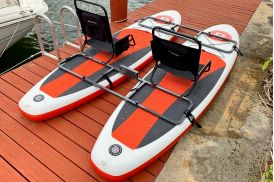
Assembly Manual (Catamaran-Frame-Assembly-Manual.pdf, 507 Kb) [ Download ]
Recommended Accessories

Customer Service
- Shipping Policy
- Payment Policy
- Return Policy
- Warranty Policy
- Legal Policy
Company Info
- About BoatsToGo
- Local Dealers
- Drop Shipment
- BoatsToGo Blog
- Clearance Sale
Tools & Resources
- Frequently Asked Questions
- Buyer's Guide
- Inflatable Boats 101
- PVC Fabric Specs
- Downloads & Forms
- Affiliate Program
- Customer's Reviews
- Preorders Updates
- Free Classifieds
- Inflatable Boats
- Inflatable Kayaks
- Inflatable Rafts
- Inflatable SUPs
- Inflatable KaBoats
- Accessories & Parts
--> Tel: 866-299-7740, 10-5PM ET Email: [email protected] Address: BoatsToGo, Inc 1945 NE 149th street North Miami, FL, 33181 By Appointments Only
© 2002-2024 BoatsToGo, Inc | [email protected]

IMAGES
VIDEO
COMMENTS
4 - 2″ stainless steel U bolts with lock nuts and washers. 4 - 5″ stainless steel eye bolts with lock nuts and washers. 1 - 8′ 2×4 (or a couple of 8″ scraps) 2 - 8″ 5/8×16 bolts with lock nuts and washers. 4 - Ratcheting straps. I also needed a rubber mallet, wrenches, a drill, a set of drill bits, and a table saw.
No matter which method you choose, making a catamaran out of two kayaks is a great way to explore open waters with added stability and capacity. With the right supplies and tools, you can have a fun and safe day on the water. Final Thoughts. Making a catamaran out of two kayaks is a great way to explore open waters with added stability and ...
This Part2/2 features the custom designed SS fixture for the shorter Pelican kayak to address the kayak height differences. The SS pipe catamaran frame is al...
has built in hardware to convert two boats into catamaran for rougth water paddling and sailing. ... Such a Vee shaped hull would be useless as a monohull, and a Hitia, although small, is far from the 2-kayak concept of the first post. ancient kayaker, Mar 25, 2009 #14. Advertisement: Joined: Mar 2009 Posts: 54 Likes: 0, Points: 0, Legacy Rep: 10
A Hobie tied knot with a Pelican: giving birth to "The Calf" - an awesome three person catamaran. We made it in such a way that one can easily assemble or di...
Amy Junior Member. Hi, I'm new to this page but I am trying to convert two scrambler xt kayaks into a catamaran. I so far have worked out basic plan and would like to get some feedback on the probility of this working. I have two scrambler xt sit on top dive kayaks. Thay are 12' long and 29" wide and can carry about 300 to 350 lbs each.
Kayakamaran. One sail rig for two kayaks makes a catamaran! See Item 6008 for the basic kit. For Deluxe and Super Deluxe packages see item 6010 and item 6011. Customer Feedback. "Hello,I just want to tell you that I had a great weekend of sailing my kayakamaran!" Ellen (June 2014) ==========. "Hi Jim & Betty,
My brother and I owned identical kayaks which we enjoyed sailing so we decided to connect them and build our yakamacat. We can assemble this at the water in ...
Does anyone out there have any experance converting two kayaks into a catamaran? Discussion in 'Multihulls' started by Amy, May 1, 2010. Page 2 of 3 < Prev 1 2 3 Next > Joined: May 2010 Posts: 10 ... The 2 x 4's in the photo that I posted, are not the 4x4's I am going to ultimately use. The 4x4's are much heavier, and significantly stronger. ...
A catamaran kayak, like the Flip-Kat®, has two hulls. This design has been around in boats for over 3000 years. Beginning with Polynesians, they were made for long voyages across the sea. Catamaran kayaks are now increasing in popularity. People enjoy the stability and comfort that these kayaks offer.
2. That's rough water. Catamarans are two boats sailing in close formation connected with by sticks. Each boat will be riding different waves and want to go their own separate way. ... Kayak Catamaran » Submitted by Grumpy - Mon, 4/9/18 » 11:11 PM. 1. Sure go ahead you might give Team Kayakphd a run for the money. But Team Lubmetender would ...
08-06-2009, 04:25 PM. Re: 2 kayaks = catamaran? Really wrong wavemaking shape, not to mention no grip on the water. Also you'd be fooling about to properly support the decks in the way of the connecting beams. Really interesting rudder problems. It would go to weather very poorly, so you'd paddle that way anyhow.
6004. The Any Kayak upwind Sail Rig with Stabilizers. Upwind sail rig for almost any kayak -- inflatable or rigid; also fits the Stearns inflatable canoe, or the Tote-N-Boat folding canoe. Attaches using straps. Makes your kayak into a complete sailboat, including leeboards, mast,sail, spars, rigging, and steering.
Unique product, designed to convert 2 inflatable stand up paddle boards into motorized catamaran. Separately, both high pressure inflatable boards can be use for stand up paddling for 2 people. Boards comes with D-rings on top, so that kayak seat or beach chair can be attached with tie downs, to use boards as a sit-n-top kayaks. Or, join both ...
As requested, here's a in-depth video of how I put my motor catamaran/kayak together. I'm sure I forgot to mention something important, so feel free to subsc...
Definition: A Catamaran, a.k.a. 'Cat' is a twin hulled watercraft that features two slender, parallel hulls of equal size, and an upper structure that holds them together at a distance from each other. This structure makes the typical catamaran a geometry-stabilized craft, that derives its lateral stability from its wide beam and the ...
I agree: the Blue Sky 360 is a bit more comprehensive. I could see this being used out in deeper water a bit easier than many light kayaks. I do love my kayaks, for sure. But, yes, there really isn't even a single innovation on it: catamaran style hulls, wheels, pedal drive, seat, rudder, etc. are all old technologies.
Does anyone out there have any experance converting two kayaks into a catamaran? Discussion in 'Multihulls' started by Amy, May 1, 2010. Page 3 of 3 < Prev 1 2 3. Joined: Oct 2006 Posts: 68 Likes: 2, Points: 0, Legacy Rep:-38 Location: Eurohut Eralnd44 Wanderer. Left it for another lover. ...
Share this on r/boatbuilding too! Nice job! I tried converting an ocean kayak to a sailboat a while ago. Except I didn't add outriggers. Ended up being extremely unstable, didnt really sail so much as blow over. 4.
Experience more stability, more space and unlimited possibilities with this all-purpose kayak that expands into the ultimate customizable catamaran! For more...
2/ Canoe and kayak sail rigs for downwind only. ... Murray River. convert canoe or kayak into a sailboat. Drop in sailing rig: storerboatplans.com. I eventually added a rudder and was able to sail it myself again. My son also taught himself to sail in it and had an enormous amount of fun. However, it was impossible to right after a capsize ...
The two floats placed beside one another and bolted down on top the frame that holds them together, (in the water) and then car topped. The other part is to make the two floats wide enough to use as two individual canoes or kayaks or the like, with out making them to bulky and slow for cat sailing. The purpose is to have fun with a little ...
Aluminum Catamaran Frame for Inflatable Paddle Boards. Convert 2 paddle boards into an electric or sail catamaran. Also can be used to install electric motor on single kayak, canoe or paddle board. See pictures for more details. Great for pleasure cruising for 1-2 people or fishing.